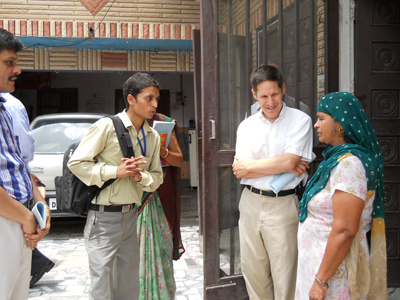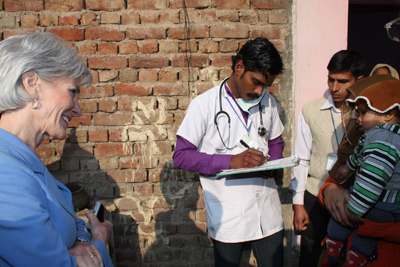Visits Highlight the Importance of CDC's Influenza Activities in India
International Program Highlight

In August 2011, CDC Director Dr. Thomas Frieden visited India and saw firsthand CDC’s important work. Dr. Frieden returned with the Secretary of the Department of Health and Human Services Kathleen Sebelius in January 2012 to learn more about CDC’s collaborations around influenza surveillance and research in India.
Dr. Thomas Frieden visiting an influenza vaccine and surveillance site in a rural village of Ballabhgarh, Haryana, India.
India is the world’s second-most populous country, accounting for 20% of global childhood deaths from respiratory infections. Historically, influenza has not been recognized as a public health priority in India; however, thanks to collaborations between CDC and scientific partners in India, the contribution of influenza to infectious disease in the country is increasingly being acknowledged.
Secretary Sebelius and Dr. Frieden met with members of India’s influenza team and the CDC Influenza Coordinator Dr. Renu Lal. The meetings included visits to influenza surveillance sites that provide health programs to the community. These sites conduct regular demographic surveillance that serves as a platform for a number of influenza studies. By integrating surveillance with established community health programs, the India influenza program is able to gain important data while using already-existing resources.
Sentinel surveillance has been a large part of the India influenza team’s work since its initiation in 2004. The team's overarching goals include identifying regional influenza circulation and informing global vaccine strain selection. Ten surveillance sites strategically distributed among all regions of India has provided invaluable data on the complexity of circulating influenza strains in India.
The India Influenza program has created broad epidemiologic and laboratory-based projects; among them are three major research activities around understanding the protection provided by influenza vaccination and estimating the burden of disease caused by influenza and other respiratory diseases. These research activities are already yielding important data.
For example, preliminary data collected through the disease burden research platform have helped characterize the impact of the 2009 H1N1 pandemic and seasonal influenza epidemics. These data have also provided the first estimates of influenza-associated hospitalization rates in India.

“The strong partnerships with our Indian counterparts and their ability to undertake large population-based surveillance provides an enormous and robust system to assess influenza burden,” said Dr. Nancy Cox, Director of Influenza Division at the CDC in Atlanta, Georgia. “The system contributes significant data in the global fight against pandemic and seasonal epidemics caused by influenza viruses.”
CDC Influenza Division team members at All India Institute of Medical Sciences in New Delhi, India for discussion on influenza vaccine studies in August 2011. [Left to right: Dipanjan Roy (CDC-India), Shobha Broor (AIIMS), Renu Lal (CDC-India), Nancy Cox, Michael Shaw, Marc-Alain Widdowson (CDC-Atlanta), Wayne Sullender (University of Alabama), and Katie Lafond (CDC-Atlanta)].
Another example of the important data emerging from CDC’s work in India comes from a current large scale population-based study that happened to be in place in rural India at the time of the 2009 pandemic. The study provided evidence of a shift in the majority of illnesses from children during the peak pandemic period to adults during the post pandemic period in August 2010. These findings from India suggest the public health response to a pandemic should consider targeted interventions for children during the early pandemic period and targeted interventions for adults in later phases of the pandemic.
“These global partnerships have helped us make great progress in our collaborative work on influenza-like illness in India,” said Secretary Sebelius during her trip.
Influenza research in India has also had other important impacts. Notably, commendable surveillance efforts led to clear identification of the seasonality of influenza viruses which in turn pointed to the public health benefit of changing the timing of influenza vaccination. The evidence-based data was instrumental in engaging India’s pharmaceutical regulatory agency (Drugs Controller General of India) to permit importation of Southern Hemisphere influenza vaccine to be given in spring of every year.
Further, an Indian manufacturer that led production of live attenuated monovalent pandemic H1N1 vaccine beginning in 2009 with support from the World Health Organization is now in the process of producing trivalent live attenuated influenza vaccine (LAIV). CDC and the All India Institute of Medical Sciences (AIIMS) in collaboration with the Serum Institute of India and the United States Biomedical Advanced Research Development Authority are in the process of establishing a surveillance site in India to undertake an efficacy trial of the locally produced LAIV.
The India influenza program is clearly making an important difference by generating evidence-based data to better understand the impact of influenza in India. After the visits to India by Dr. Frieden and Secretary Sebelius, Dr. Lal took a moment with us to reflect on factors that have led to the program’s success over the years.
“We’ve found that a holistic approach that encompasses activities ranging from surveillance to broad intervention strategies, together with strong partnerships with host countries can be a turning point for influenza prevention and control,” says Dr. Lal. “Similar strategies can also be applied for other emerging infectious diseases in India,” she notes.

Secretary Sebelius interacting with a sick child. Rural village about 50km from Delhi, India.

Secretary Sebelius listening to a field staff nurse taking a history from a child’s family. Rural village about 50km from Delhi, India.
Photos courtesy of: Drs. Vivek Gupta, Debjani R. Purakayastha and Arrvind Singh
Contact Us:
- Centers for Disease Control and Prevention
1600 Clifton Rd
Atlanta, GA 30333 - 800-CDC-INFO
(800-232-4636)
TTY: (888) 232-6348 - Contact CDC-INFO



